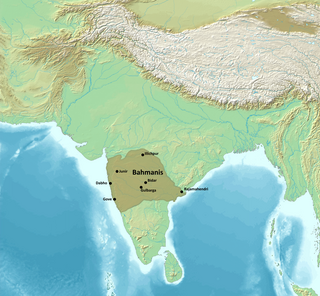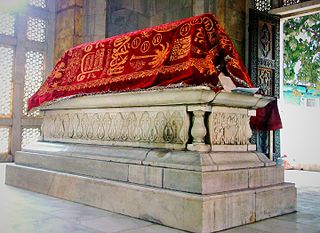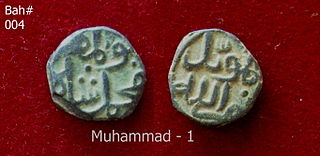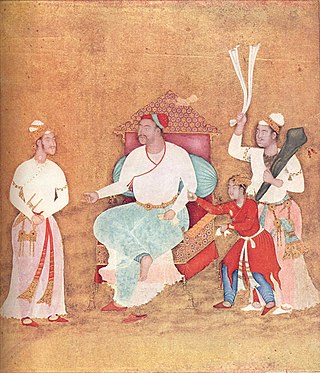Related Research Articles

The Delhi Sultanate or the Sultanate of Delhi was a late medieval empire primarily based in Delhi that stretched over large parts of the Indian subcontinent, for 320 years (1206–1526). Following the invasion of South Asia by the Ghurid dynasty, five dynasties ruled over the Delhi Sultanate sequentially: the Mamluk dynasty (1206–1290), the Khalji dynasty (1290–1320), the Tughlaq dynasty (1320–1414), the Sayyid dynasty (1414–1451), and the Lodi dynasty (1451–1526). It covered large swaths of territory in modern-day India, Pakistan, and Bangladesh as well as some parts of southern Nepal.
The Sayyid dynasty was the fourth dynasty of the Delhi Sultanate, with four rulers ruling from 1414 to 1451 for 37 years. The first ruler of the dynasty, Khizr Khan, who was the Timurid vassal of Multan, conquered Delhi in 1414, while the rulers proclaimed themselves the Sultans of the Delhi Sultanate under Mubarak Shah, which succeeded the Tughlaq dynasty and ruled the Sultanate until they were displaced by the Lodi dynasty in 1451.
The Deccan sultanates is a historiographical term referring to five late-medieval Indian kingdoms on the Deccan Plateau between the Krishna River and the Vindhya Range—that were created from the disintegration of the Bahmani Sultanate and ruled by Muslim dynasties: namely Ahmadnagar, Berar, Bidar, Bijapur, and Golconda. The sultanates had become independent during the break-up of the Bahmani Sultanate. The five sultanates owed their existence to the declaration of independence of Ahmadnagar in 1490, followed by Bijapur and Berar in the same year. Golconda became independent in 1518, and Bidar in 1528.

The Bahmani Sultanate was a late medieval empire that ruled the Deccan Plateau in India. The first independent Muslim kingdom of the Deccan, the Bahmani Sultanate came to power in 1347 during the rebellion of Ismail Mukh against Muhammad bin Tughlaq, the Sultan of the Tughlaq dynasty of Delhi. Ismail Mukh then abdicated in favour of Zafar Khan, who would establish the Bahmani Sultanate.

Qutb ud-Din Aibak was a general of the Ghurid emperor Muhammad Ghori. He was in charge of the Ghurid territories in northern India, and after Muhammad Ghori's assassination in 1206, he established the Delhi Sultanate (1206–1526), and started the Mamluk dynasty, which would rule the Sultanate until 1290.

The Mamluk dynasty, also known as Slave dynasty, was a dynasty which ruled the Delhi Sultanate from 1206 to 1290. It was the first of five largely unrelated dynasties to rule the Delhi Sultanate until 1526. Before the establishment of the Mamluk dynasty, Qutb al-Din Aibak's tenure as a Ghurid dynasty administrator lasted from 1192 to 1206, a period during which he led forays into the Gangetic plain and established control over some of the new areas.

Muhammad bin Tughluq, also named Jauna Khan as Crown Prince, also known by his epithets, The Eccentric Prince, or The Mad Sultan, was the eighteenth Sultan of Delhi. He reigned from February 1325 until his death in 1351. The sultan was the eldest son of Ghiyath al-Din Tughluq, founder of the Tughlaq dynasty. In 1321, the young Muhammad was sent by his father to the Deccan Plateau to fight a military campaign against the Kakatiya dynasty. In 1323, the future sultan successfully laid siege upon the Kakatiya capital in Warangal. This victory over King Prataparudra ended the Kakatiya dynasty.

The Khalji or Khilji dynasty was the second dynasty which ruled the Delhi sultanate, covering large parts of the Indian subcontinent for nearly three decades between 1290 and 1320. It was founded by Jalal ud din Firuz Khalji.

Ala ud-Din Masud Shah was the seventh sultan of the Delhi Sultanate.

Ma'bar Sultanate, also known as the Madurai Sultanate, was a short lived kingdom based in the city of Madurai in Tamil Nadu, India. It was Urdu speaking. The sultanate was proclaimed in 1335 CE in Madurai led by Jalaluddin Ahsan Khan, a native of Kaithal in North India, declared his independence from the Sultanate of Delhi.
The Farooqi dynasty or the Farooq Shahi was the ruling dynasty of the Khandesh Sultanate from its inception in 1382 till its annexation by the Mughal emperor Akbar in 1601. The founder of the dynasty, Malik Ahmad participated in a rebellion against the Bahmani ruler Muhmmad Shah I in his early years. When he was compelled to flee from Deccan, he established in Thalner on the Tapti River. After receiving the grant of the fiefdoms of Thalner and Karanda from Firuz Shah Tughluq in 1370, he conquered the region around Thalner, which later became known as Khandesh. By 1382, he started ruling independently.

Ala-ud-Din Hasan Bahman Shah whose original name was Zafar Khan or Hasan Gangu, was the founder of the Bahmani Sultanate.

Mohammed Shah I was the second ruler of the Bahmani Sultanate, a late medieval kingdom of India. He succeeded his father Ala-ud-Din Bahman Shah. He initiated the Bahmani–Vijayanagar War with two neighboring kingdoms, the Vijayanagara and the Warangal under Kapaya Nayaka, and successfully subjugated them. He was succeeded by his son Alauddin Mujahid Shah.

Taj ud-Din Firoz Shah, also known as Firoz Shah Bahmani, was the ruler of the Bahmani Sultanate from 16 November 1397 to 22 September 1422. Firuz Shah is considered an important ruler of the Bahamani Sultanate. He expanded his kingdom and even succeeded in conquering the Raichur Doab from Vijaynagara kingdoms.

The Deccanis or Deccani people are an Indo-Aryan ethno-religious community of Deccani-speaking Muslims who inhabit or are from the Deccan region of Western and Southern India. The community traces its origins to the shifting of the Delhi Sultanate's capital from Delhi to Daulatabad in 1327 during the reign of Muhammad bin Tughluq. Further ancestry can also be traced from immigrant Muslims referred to as Afaqis, also known as Pardesis who came from Central Asia, Iraq and Iran and had settled in the Deccan region during the Bahmani Sultanate (1347). The migration of Muslim Hindavi-speaking people to the Deccan and intermarriage with the local Hindus whom converted to Islam, led to the creation of a new community of Hindustani-speaking Muslims, known as the Deccani, who would come to play an important role in the politics of the Deccan. Their language, Deccani, emerged as a language of linguistic prestige and culture during the Bahmani Sultanate, further evolving in the Deccan Sultanates.

The Chahamanas of Ranastambhapura were a 13th-century Indian dynasty. They ruled the area around their capital Ranastambhapura (Ranthambore) in present-day Rajasthan, initially as vassals of the Delhi Sultanate, and later gained independence. They belonged to the Chahamana (Chauhan) clan of the Rajputs, and are also known as Chauhans of Ranthambore in vernacular Rajasthani bardic literature.
Deval Devi was the daughter of Karan Deva II. She was married to Khizr Khan, the eldest son of Alauddin Khalji, in 1308. Eight years later, Khizr Khan was executed by his brother Qutb ud din Mubarak Shah, and Deval was taken into the latter's harem. In 1320, Mubarak in turn was stabbed and beheaded by his supposed favourite, Khusro Khan, and his followers. Deval was then married to Khusro Khan. Her story, of being passed from hand to hand amongst a series of ambitious, power-hungry Muslim men is the basis of the celebrated Gujarati historical novel Karan Ghelo authored by Nandshankar Mehta.
Abdul Malik Isami (1311–?) was a 14th-century Indian historian and court poet. He wrote in the Persian language, under the patronage of Ala-ud-Din Bahman Shah, the founder of the Bahmani Sultanate. He is best known for Futuh-us-Salatin, a poetic history of the Muslim conquest of India.
The rebellion of Ismail Mukh took place between 1346 and 1347 when Deccani Amirs placed Ismail Mukh, also known as Nasir-ud-din Ismail Shah, an Afghan noble, at the head of a rebellion centered at Daulatabad. The rebellion saw the decline and loss of the Delhi Sultanate's control over the Deccan, which had been a part of the Delhi Sultanate since the Khilji dynasty. Ismail Mukh abdicated in favor of Zafar Khan, on 3 August 1347, which saw the establishment of the Bahmani Sultanate, which existed from 1347 to 1527.
References
- 1 2 Bhattacharya 1972, p. 100.
- ↑ Cathal J. Nolan (2006). The Age of Wars of Religion, 1000-1650: An Encyclopedia of Global ..., Volym 1 . pp. 437.
- ↑ The Discovery of India, J.L.Nehru
- ↑ Chandra 2004, p. 177.
- ↑ Majumdar 1967, p. 248.
Works cited
- Bhattacharya, Sachchidananada (1972), A Dictionary of Indian History, Westport: Greenwood Press
- Chandra, Satish (2004), Medieval India: From Sultanat to the Mughals-Delhi Sultanat (1206–1526) – Part One, Har-Anand Publications, ISBN 978-81-241-1064-5
- Majumdar, Ramesh Chandra (1967), The Delhi Sultanate, Bharatiya Vidya Bhavan